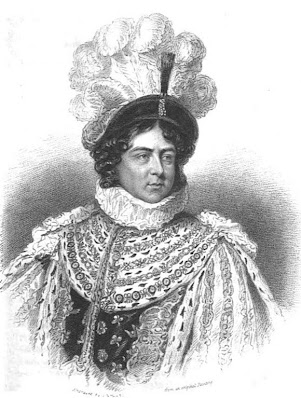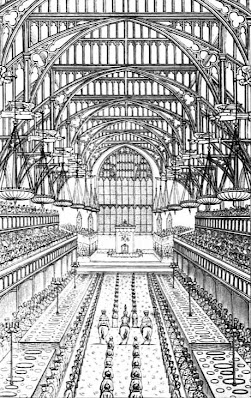On 19 July 1821, thousands of people crowded into the streets around Westminster Abbey in order to catch a glimpse of George IV on his coronation day.
You can read about the dress crisis faced by those fortunate enough to have tickets to the coronation here.
But what was the King wearing on this day he had looked forward to for so long?
But what was the King wearing on this day he had looked forward to for so long?
George IV’s coronation robes
 |
| George IV in his coronation robes from A Biographical Memoir of Frederick, Duke of York and Albany by John Watkins (1827) |
When the King entered Westminster Hall, prior to the procession to the Abbey, at precisely 10 o’clock, he was:
...habited in robes of enormous size and richness, wearing a black hat with a monstrous plume of ostrich feathers, out of the midst of which rose a black heron’s plume.1
These enormous robes consisted of a silver dress à la Henri Quatre made of silver tissue trimmed with silver lace. Over this he wore a surcoat of crimson velvet with buckle, scabbard and sword-belt, all covered with diamonds, and over this, he wore:
...a crimson velvet robe, nine yards in length, lined throughout with the finest ermine, and most exquisitely embroidered, representing the crown and Gloria, trophies, &c. interwoven with laurels, palm, &c.2
 |
| George IV in his coronation robes from An authentic history of the coronation of His Majesty, King George the Fourth by Robert Huish (1821) |
During the coronation, the robes the King was wearing were taken off and he was clothed in the robe royal or purple robe of state of cloth of tissue lined or furred with ermine. After the ceremony, this robe was taken off again and the crimson velvet robes were put back on.
The crowns
There were two crowns - St Edward’s crown, with which King was formally crowned, and the crown of state, which had been made expressly for George IV.
St Edward’s crown was:
St Edward’s crown was:
a very rich imperial crown of gold, embellished with pearls and precious stones of divers kings, viz. diamonds, rubies, emeralds and sapphires, and a mound of gold on the top of it, encircled with a band or fillet of gold, embellished also with precious stones, and upon the mound a cross of gold, embellished likewise with precious stones, and three very large oval pearls, one at the top of the cross and two others pendant at the ends of the cross.2“The cap within the said crown is of purple velvet, lined with white taffeta, and turned up with ermine” matching the purple robe of state that the King wore for the coronation ceremony itself.2
The crown of state was encrusted with diamonds and the cap inside it was made of crimson velvet. This matched the elaborate coronation robes and train that the King wore to process into the Abbey and which he donned again to process back into Westminster Hall after the coronation ceremony, wearing the crown of state.
Suffering in the heat
Fortunately July 1821 was not as warm as July 2013, but the heat still caused some problems. According to Huish:
The Coronation of George IV took place in the dog-days, when although the weather was not extremely hot, and every precaution had been taken to give a proper ventilation to the Hall, yet towards the close of the banquet, the heat became so oppressive, that several of the ladies fainted, and the superb dresses of the peers and peeresses were spoiled by the profuse globules of melted wax which were continually falling upon them.2As Gossip observed:
His Majesty seemed very much oppressed with the weight of his robes. The train was of enormous length and breadth. It was of crimson velvet adorned with large golden stars, and a broad golden border. His Majesty frequently wiped his face while he remained seated.1
 | |
| The coronation banquet, Westminster Hall from An authentic history of the coronation of His Majesty, King George the Fourth by Robert Huish (1821) |
Rachel Knowles writes faith-based Regency romance and historical non-fiction. She has been sharing her research on this blog since 2011. Rachel lives in the beautiful Georgian seaside town of Weymouth, Dorset, on the south coast of England, with her husband, Andrew.
Find out more about Rachel's books and sign up for her newsletter here.If you have enjoyed this blog and want to encourage us and help us to keep making our research freely available, please buy us a virtual cup of coffee by clicking the button below.
Notes
1. From Coronation anecdotes by Giles Gossip.
2. From An authentic history of the coronation of His Majesty, King George the Fourth by Robert Huish.
Sources used include:
Gossip, Giles, Coronation anecdotes (1823)
Huish, Robert, An authentic history of the coronation of His Majesty, King George the Fourth (1821)



I can only imagine the heat!
ReplyDelete